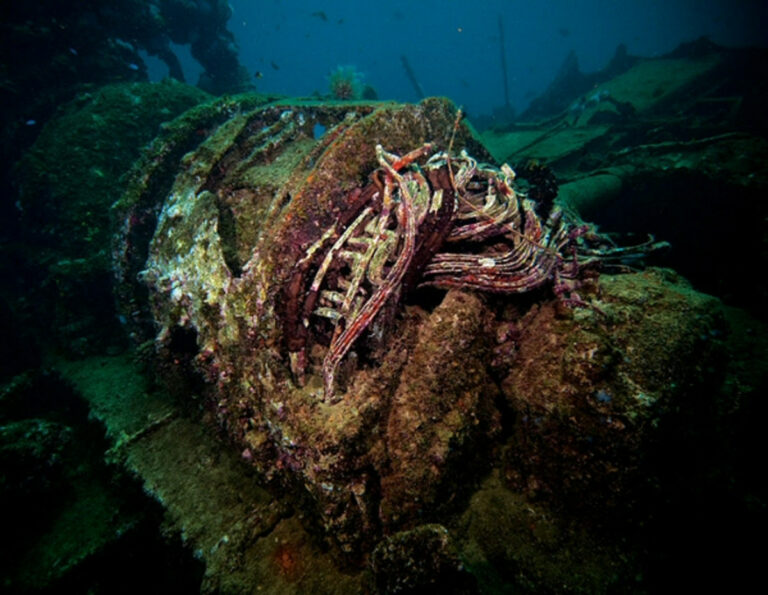Aruba is the forgotten ABC island so far as British divers are concerned, with Bonaire and Curaçao enjoying a higher profile – but with all its wreck assets it deserves more attention, says John Liddiard.
UNLIKE COCOMO in the Beach Boys’ song, Aruba really exists. Down at the southern edge of the Caribbean, off the Venezuela coast, the Dutch islands Aruba, Bonaire and Curacao are often referred to collectively as the “ABC” islands.
Bonaire and Curacao are bigger and, especially in the case of Bonaire, better known for diving, but it is Aruba that has lots of wrecks, from steamships sunk by navigational disaster over a century ago to wartime casualties and, more recently, a variety of artificial reefs. Aruba claims the greatest number of shipwrecks in the southern part of the Caribbean.
It isn’t the first dive of my trip, but I can’t resist beginning my story with the ss Antilla which, at 2164 tons and 121m long, is Aruba’s biggest and best-known wreck.
The boat from Jads dive centre collects me from Pelican Pier, almost directly inshore from the wreck, so the journey takes only a few minutes. Just as well, because the boat is almost full for this popular trip.
The Antilla is only 12m to the seabed, so we first make a deeper dive on the nearby Debbie II, of which more later.
Built in Hamburg in 1939, the Antilla was serving as a U-boat supply ship when, on 10 May, 1940, Germany invaded the Netherlands.
Dutch marines stationed on Aruba demanded her surrender, but the captain negotiated a 24-hour delay, during which he ran the boilers up to maximum temperature and, after the crew had abandoned ship, opened the sea cocks.
Cold water running over the boilers caused an explosion that sank the Antilla and damaged the hull sufficiently to make the ship unsalvageable.
The dive briefing informs us that Antilla has since been rolled and broken by storms, and lies mostly on its port side; our guide is playing it down a bit, as the wreck used to be more intact.
Once down, I wonder why he does so. While the hull is broken and the decks have collapsed, the starboard side still rises to just short of the surface for most of the length of the hull.
The Antilla is considerably more intact than many fine wrecks I have dived in UK waters. It’s magnificent!
I HEAD FORWARD PAST REFRIGERATION machinery and masts projecting almost parallel to the seabed, with some excellent coral and sponge growth both on the masts and on the cables dangling from them.

Big schools of fish loiter where a light current pushes through breaks in the hull and round the bow.
While the bow deck is vertical, and most of the main deck would have been vertical before collapsing, the stern has obviously been resting only halfway over to port for a long time, rudder and keel touching the seabed.
All but one of the bronze blades of the prop have been unbolted and salvaged. The remaining blade is less accessible beneath the keel, with a nice shiny patch along one edge, where divers have polished it.
Antilla memorabilia can be seen in Charlie’s Bar, though it did take Charlie Jr to point it out to me among the mass of other tat nailed to both walls and ceiling.
Charlie’s is just outside the oil refinery and has been accumulating decorations since Charlie Sr opened it in 1941. A urinal from the Antilla is mounted above the toilet door, where no-one could possibly use it by mistake.

I dive Aruba’s other wartime wreck with Unique Sports Aruba, or USA, as it is abbreviated.
The boat leaves the beach a couple of piers further south for an afternoon dive on the remains of the Pedernales, a tanker torpedoed by long-range type IXC U-boat U156, on 16 February, 1942.
The Pedernales burned all night without sinking, and was then pushed aground. With the fire out, the damaged section was cut out and the bow and stern dry-docked and rejoined temporarily before she steamed to Baltimore under her own power.
The rebuilt Pedernales survived the war, to be scrapped in 1959.
In the same attack, U156 also torpedoed the tanker ss Oranjestad, which did not sink, then surfaced to shell storage tanks at the oil refinery.
The gun crew unfortunately neglected to remove the plug or “tampon” from the end of the gun, and the resulting explosion killed one gunner and seriously wounded another.
U156 then torpedoed another tanker, ss Arkansas, missing with torpedoes from the bow tubes before hitting with a single torpedo from the stern tube. Arkansas remained afloat, and later steamed to Galveston for full repairs.
Later in the patrol, the damaged part of U156’s gun barrel was sawn off, and the gun used to sink two more ships.
With bow and stern salvaged, the Pedernales wreck consists of scattered parts of the damaged centre section.
Here I admit a beneficial mistake. The plan had been to dive a shallow reef, so I set my camera up with a macro lens. Then, on the boat, the dive is switched to the Pedernales because vis on the reef was reported to be murky.
Usually I would have been taking wide-angle photographs on a wreck, but as it turns out the 7m-deep Pedernales and adjacent rubble seabed is teeming with fantastic macro opportunities. It’s easy to get down low for good angles on shrimps, crabs, a tiny honeycomb moray eel and lots of fish.

My only disappointment is that, while the guide shows me its home beneath an overhang, the frogfish is not in.
BACK TO THE DEBBIE II, a 37m fuel barge sunk as an artificial reef in 1992. Descending the line attached near the bow, my attention is drawn to a shoal of grunts loitering by the foot of the forward mast, then to nice corals and especially sponges round the bow and on the railings.

Along the centre-line of the barge are the usual pipe systems found on a tanker, and at the stern a deckhouse with an empty motor-room below.

The barge had no engine to turn a propeller, but it still needed generators and pumps to operate.
Rounding the stern, to the starboard side of the deckhouse, I unexpectedly encounter a lionfish loitering on the deck.
Lionfish are not a native species in the Caribbean, but have been spreading since first being sighted off Florida getting on for 20 years ago.
The first sighting in Aruba came last September. I hadn’t realised they had worked this far south in the Caribbean.
The Debbie II lies alongside Malmok reef, so with time I could have left the wreck to explore the reef.
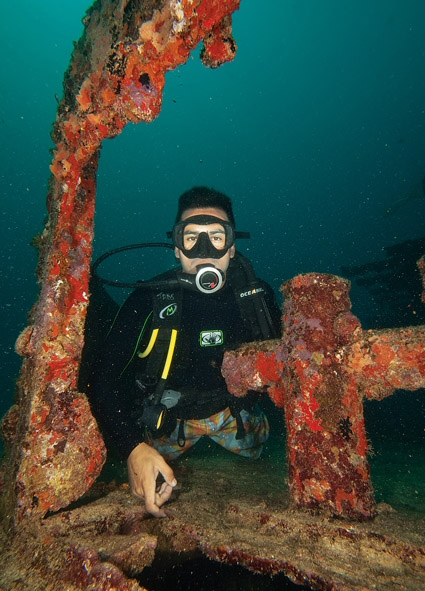
Instead, the lionfish consumes the rest of my dive, first in photographing it, then in watching the dive guides’ unsuccessful attempt to catch it using a kit box, the best implement available at the time. A local restaurant offers $30 per fish, both for its tables and to reduce their impact on the reef.
As a first dive before the Pedernales, I dive two aircraft wrecks off Renaissance island, close to the airport.
Neither are flying mishaps. The first is a Convair CV-240, confiscated from drug-smugglers in the late 1980s and sunk as an artificial reef.
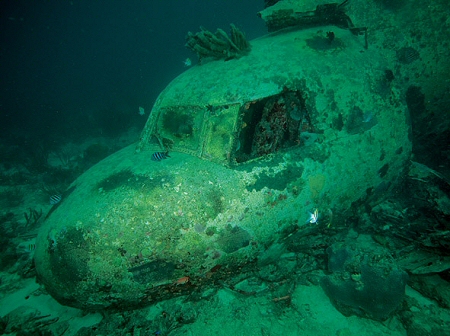
It shifted and was broken by Hurricane Lenny in 1999, so in 2004 a Japanese built YS-11, decommissioned by Air Aruba, was sunk nearby and remains very intact.
Both were twin-prop aircraft, though the YS-11 was a bit bigger, and carried 64 passengers to the Convair’s 40.
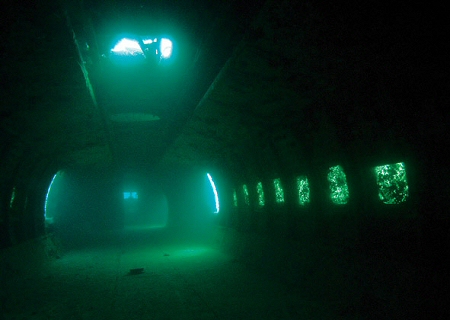
Both were gutted, with the passenger cabins now empty tubes, then moved from airport to dive site on barges.
Depending on your interest in aircraft wrecks, this site makes one or two dives.
You could dive one plane before spending time on the sloping reef, or, like me, swim from one wreck to the other to split a more rectangular-profile 20-25m dive between the two.
MY DIVING IS SPLIT between Jads and Unique Sports, respectively based a few miles south and north of where I am staying at the Divi Resort. It hardly matters where divers are staying, because both dive centres pick up from the hotel area and downtown.
The only time personal transport would be an advantage is in the evenings, to get out for dinner.
The Divi Resort is all-inclusive, so I take advantage of the hotel for lunch and ice creams and stay for dinner one evening, but overall I like to see and experience dining further afield.
If standard chains are your thing, the usual American restaurants are available, from Wendy’s to Hooters.
Fortunately, the Aruba Tourism Authority has more enticing venues to show me. Madame Janette’s Restaurant is immensely popular for its top-quality Caribbean and international cooking, as is the Flying Fishbone, where the tables spread down the beach, the front row in a few inches of water.
Nos Canucu has a smaller international menu, but specialises in traditional Aruban food. I try keshi yena, a hollowed-out cheese stuffed with meat, as a main course.
For a starter, I am more daring, I have the iguana soup. It’s more expensive than burger chains, but the prices are reasonable. I often think that the ideal job to complement my diving would be as a restaurant reviewer!
Aruba has a few more natural wrecks, like the ss California, sunk off the north coast in 1891 and lending its name to Aruba’s California lighthouse, but the others I dive are artificial reefs.
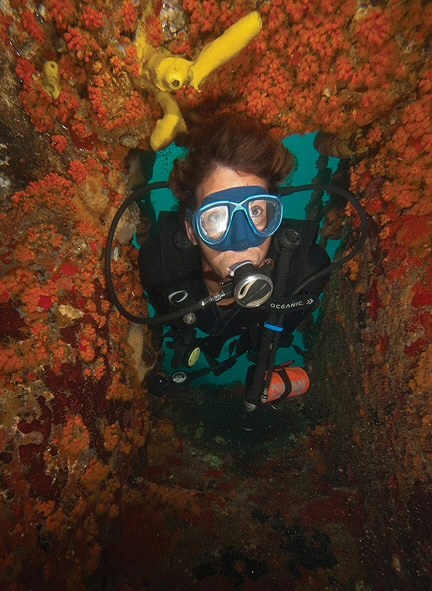
From the Jads boat, I visit the 76m cement-carrier Jane Sea and the 67m tanker Star Gerren.
The Jane Sea was sunk in 1988 and rests upright, bow up the slope at 10m.
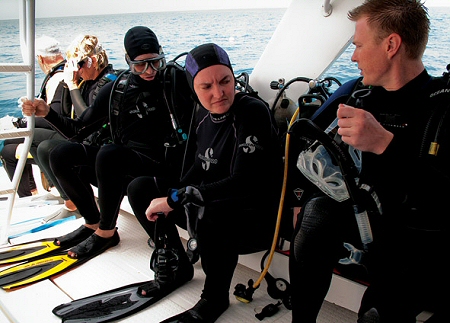
Perfectly located across a mild current, the wreck has accumulated a respectable growth of small hard corals, larger sponges and black gorgonians.
It’s the most colourful wreck of the trip.
Back from the bow, after a bright red and yellow anchor winch is an equally bright red and yellow cab from a cargo-handling crane, then a more conventional cargo-winch before the holds. The bright colors come from encrusting sponges and, beneath overhangs, small cup corals.
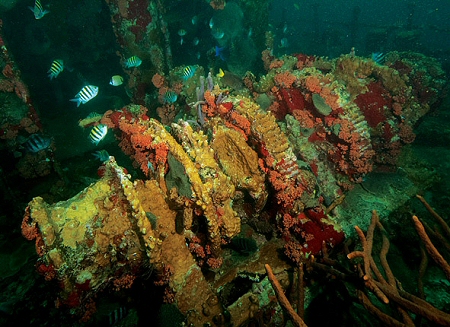
Beneath the stern at 30m, the propeller was left in place, and the whole area is a mass of black gorgonians and whips. Inside the stern, the engine-room is accessible, with marine diesel, generators and pumps.
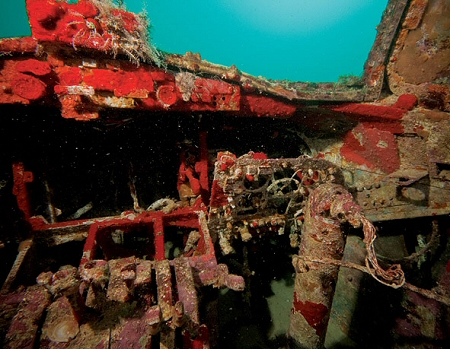
The Star Gerren is more recent. This tanker was originally sunk in 2000, to rest on its port side on a flat sandy seabed in 18m.
Since then it has tipped further over, so the deck overhangs the superstructure and deckhouses that hold it clear of the sand. Unless you want to look at the small sprigs of coral just taking hold along the keel, the dive is a rectangular profile beneath the deck.
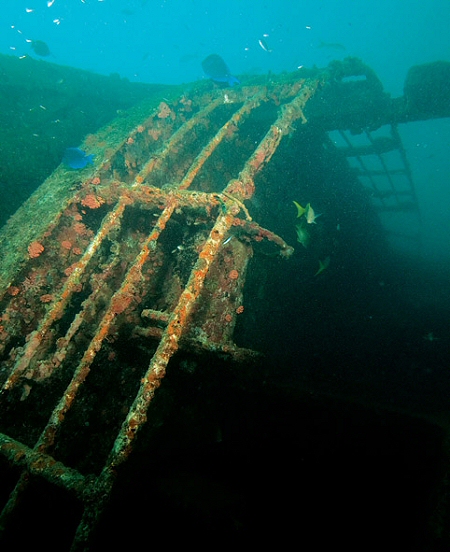
Each low overhang is home to a swarm of juvenile grunts, while solitary snapper loiter nearby for lunch.
A shadow further beneath the wreck shifts, and a shy grouper gives itself away.
Now looking in earnest, I see quite a few grouper tucked into the narrow spaces and shadows, no doubt also watching their lunch – there is plenty to go round.

AS I RETURN TO THE BUOYLINE tied the rudder, a shadow across my downward view causes me to look up and see a sizeable sting ray fly across. Perhaps a diver on the other side of the wreck has spooked it in my direction.
Aruba’s newest wreck is the Kappel, a small steel boat sunk last year in a sand bowl behind the reef at Mangel Halto Beach. It’s an easy, sheltered shore dive, adding interest to a training site in 16m.
Initially, I think it hasn’t been down long enough for anything to start growing on it, but below the stern I realise that the Kappel already has several years of growth from where it had lain derelict at its mooring.
After swimming through the cabin, I head out to an isolated head of coral on the sand, and a moray eel.
Between wrecks I do a couple of dives on reefs: a second shore dive to follow the Kappel at the aptly named Rocky Beach, then a boat dive at Harbour Reef.

Both slope gently down to a sandy seabed with some respectable hard corals, gorgonians and sponges.
It’s easy and pretty, though there is none of the “wow” scenery such as steep walls and pinnacles that other locations are famous for – Aruba’s distinguishing feature is its wrecks.
Still, I meet co-operative shrimps and lobsters, big shoals of grunts and Creole wrasse, and a very friendly French angelfish. I don’t know whether it’s me she fancies, or her own reflection in my camera dome.
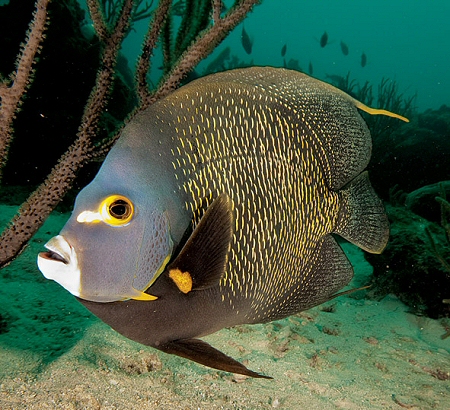
FACTFILE
GETTING THERE: Fly with American Airlines via Miami. You will need an ESTA (Electronic System for Travel Authorization) to fly via the USA, available at US Customs and Border Protection. This is free, so beware the many websites that charge for one.
DIVING: Jads Dive Centre, www.jadsaruba.com. Unique Sports Aruba website.
Accommodation John Liddiard stayed at the Divi Resort.
MONEY: Netherlands Antilles guilder or US dollar.
WHEN TO GO: Year-round. The ABC Islands are south of the hurricane belt.
PRICES: If you want a package, Thomson Holidays offers Divi Resort all-inclusive from £1125 a week (two sharing). A five-dive package at Jads costs US $195.
TOURIST INFORMATION: Visit Aruba website

